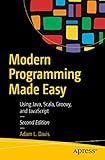Best Groovy Scripting Tools to Buy in December 2025
To run Maven commands using a Groovy script, you can use the ProcessBuilder class to execute external commands. You need to create a new ProcessBuilder instance and set the command to be executed (in this case, the Maven command).
Here is an example of how you can run a Maven command using Groovy script:
def command = "mvn clean install" def processBuilder = new ProcessBuilder(command.split(" ")) processBuilder.directory(new File("/path/to/your/project")) def process = processBuilder.start() process.waitFor() println "Maven command executed successfully"
In this script, we first define the Maven command to be executed (in this case, mvn clean install). We then create a new ProcessBuilder instance with the command split into individual parts. Next, we set the directory where the Maven command should be executed. Finally, we start the process and wait for it to finish before printing a success message.
You can customize this script to run different Maven commands or perform additional tasks before or after executing the command.
How to set up a Groovy script environment?
To set up a Groovy script environment, follow these steps:
- Install Java: Make sure you have Java installed on your system as Groovy runs on the Java Virtual Machine (JVM). You can download and install Java from the official Oracle website.
- Download Groovy: Go to the Groovy website (https://groovy-lang.org/download.html) and download the latest version of Groovy for your operating system.
- Set up the Groovy environment variables: After downloading Groovy, extract the contents of the zip file to a suitable location on your system. Then, set the GROOVY_HOME environment variable to the directory where you extracted the Groovy files.
- Add Groovy to the PATH: To make it easier to run Groovy scripts from any location on your system, add the Groovy bin directory to your system's PATH environment variable.
- Test the Groovy installation: Open a terminal or command prompt and type "groovy -v" to check if Groovy is successfully installed on your system. You should see the version of Groovy installed on your system.
- Write and run a Groovy script: Now that you have set up the Groovy environment, you can start writing and running Groovy scripts. Create a new text file with a .groovy extension, write your Groovy code, and save the file. Then, open a terminal or command prompt, navigate to the directory where you saved the Groovy script, and run it by typing "groovy yourscript.groovy".
By following these steps, you can set up a Groovy script environment on your system and start writing and running Groovy scripts.
What is the purpose of the settings.xml file in Maven?
The settings.xml file in Maven is used to store configuration settings that are specific to a user's environment or Maven installation. This file is typically located in the conf directory of the Maven installation and can be used to configure things such as proxy settings, repository URLs, authentication credentials, and plugin groups. By using the settings.xml file, users can customize their Maven setup to better suit their needs and environment.
How to run multiple Maven commands in sequence in a Groovy script?
You can run multiple Maven commands in sequence in a Groovy script by using the ProcessBuilder class to execute the Maven commands one after the other. Here is an example of how you can do this:
def commands = ["mvn clean", "mvn compile", "mvn test"]
commands.each { command -> def processBuilder = new ProcessBuilder(command.split()) processBuilder.directory(new File("/path/to/your/project")) def process = processBuilder.start()
process.waitFor()
if (process.exitValue() != 0) {
println "Error executing command: $command"
System.exit(1)
}
}
println "All Maven commands executed successfully"
In this script, we define an array of Maven commands that we want to run in sequence. We then iterate over each command in the array, create a new ProcessBuilder instance with the command split into individual arguments, set the working directory to the project directory, and start the process.
We then wait for the process to finish executing and check the exit value. If the exit value is non-zero, we print an error message and exit the script with a non-zero exit code. Otherwise, we continue to the next Maven command in the sequence.
Finally, we print a message indicating that all Maven commands have been executed successfully.
You can run this script in a Groovy environment such as the Groovy console or by saving it to a file and executing it using the Groovy command line tool.




